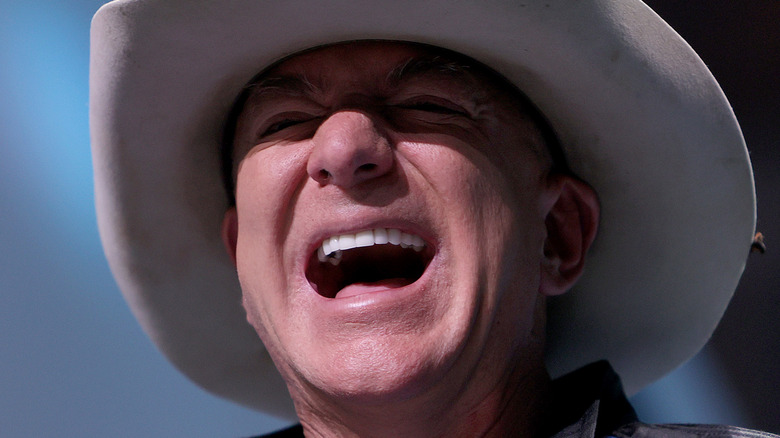The Truth About Jeff Bezos' 10,000 Year Clock
Well, the space cowboy's done it again. Jeff Bezos can add another notch to his belt: "Guy who made a giant clock that will likely outlive humanity." Bezos, the second-richest person in the world (after Elon Musk, per the Bloomberg Billionaires Index on February 17), has been drilling tunnels into the Sierra Diablo Mountain Range in Texas to construct a 500-foot-tall clock that will "keep time for the next 10,000 years," as Bezos writes in a digitally signed letter on the 10,000-year Clock official website.
In all fairness, this particular bit of ambition seems more benign than, say, requesting the city of Rotterdam deconstruct its historic bridge, a symbol of the city itself, to let his $500-million yacht float through (via NPR). So what's the purpose of the 10,000-year clock? To promote "more long-term thinking" to help humanity solve the very "civilization-scale problems" it has itself created. Let's not overlook the blinding irony of these words being spoken by the man who built a company that forces its drivers to urinate into bottles to make deliveries on time (explained on the BBC).
The "Clock of the Long Now" (its official name) is the brain-child of "inventor, scientist, engineer, author, and visionary" (per Long Now) Danny Hillis. By all accounts, Hillis envisioned this project back in 1986 (per Interesting Engineering), pitched it in 1995 on Wired (per The Verge), and sometime later got his monetary windfall in the form of a billionaire patron to set the project's gears turning.
Pilgrimage site for the future
It's true that the Clock of the Long Now is an astounding piece of collaborative engineering, artistry and design. On Twitter, Bezos posted a short video depicting the construction and inner guts of the clock, including footage of a geared mechanism being lowered into the interior of the clock's mountain face. The whole thing is mechanical — no digital parts — and powered by thermal vents. It also houses five "room-sized anniversary chambers," as Interesting Engineering says, for the clock's 1, 10, 100, 1,000, and finally 10,000-year anniversaries. The one-year anniversary chamber is set to contain some sort of solar system diorama, while the remaining chambers "will be left for future generations to create." Also, as The Verge says, it cost about $42 million.
The Clock of the Long Now is designed as a kind of pilgrimage site to ponder the fate of humanity. Folks will be able to visit it, but as Bezos writes on the 10,000-year clock website, it will take "commitment" to do so. The nearest airport is "several hours away by car." After that, pilgrims will have to traipse along a hiking trail that rises "2,000 feet above the valley floor," and which may or may not require climbing (judging by pictures).
Whether the clock is a testament to human genius or pride is up to the reader. Perhaps future, space-dwelling descendants of a Blue Origins-launched, Bezos-funded rocket can swing by Earth to visit and pay homage to their progenitor.

